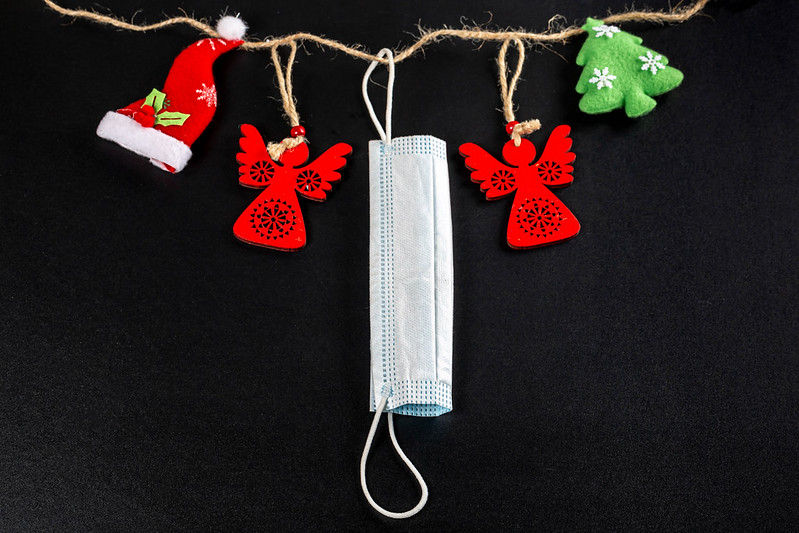
With less than four weeks to go before Christmas, decorations are going up in shopping centres, public spaces and private homes. This year, excitement and anticipation are mixed with fear and uncertainty. Christmas 2019 was the last ‘pre-COVID’ celebration of that festival. We are now in the ‘post-COVID’ world: the term I give to the era after the world first heard about the unusual pneumonia-like illness affecting people in Wuhan at the very end of 2019.
In this first post-COVID Christmas, uncertainty reigns about how best to celebrate the festival. A range of COVID-themed Christmas decorations are readily found online. These include baubles featuring images of Christmas icons such as Santa Claus or cute reindeer wearing masks. The novel coronavirus itself can be found rendered in Christmas-themed decorations (dubbed ‘pandemic ornaments’) for trees: in bright green and red hues, gold and glittery or grouped with other COVID iconic objects such as toilet rolls and masks. Other COVID customised decorations declare 2020 as ‘The year we stayed home‘ or display the words ‘Merry Christmas’ together with a coronavirus symbol wearing a jolly Santa hat. A less merry tree ornament features the dread image of the mediaeval plague doctor’s mask.
Face masks themselves can be obtained for wear at gatherings with Christmassy-themed patterns. Even Christmas stockings designed for holding Santa gifts for young children can be purchased with COVID themes emblazoned on them (‘Purple Viral Particle Large Christmas Stocking‘, anyone?).
At first glance, given the devastation that the COVID crisis has wrought globally, these ways of commemorating the ‘COVID year of 2020’ may seem jarring, a tasteless example of commercial entrepreneurialism and disrespectful to the dead or those who have been cast into poverty because of losing employment. In many countries, such as the USA Brazil and India, coronavirus infections and COVID deaths are increasing daily, with little sign of abating. The world has recorded the grim total of nearly 1.5 million deaths from COVID (and this figure is likely a gross underreporting).
In many countries in which Christmas is traditionally a significant festival, such as the UK, people are being urged to form ‘bubbles’ with a small number of other households – or even to reconsider celebrating Christmas at all with gatherings. Fears are rightly held by health authorities in the USA for the possibility of Christmas-related surges of infections, due to people dropping their guard when meeting loved ones and not engaging in physical distancing, wearing masks or opening enough windows (in what will be very cold conditions for many people celebrating in the Northern Hemisphere).
In Australia, where the coronavirus at the moment is well-contained, federal and state governments have made pronouncements about the importance of opening state borders to allow travel across the country for Christmas. Yet the recent example of an unexpected outbreak in the city of Adelaide, followed by the sudden re-closure of some state borders, gives pause for those who may be considering interstate travel for the festivities. Once over the border, they may find themselves stuck in quarantine or unable to travel back home if there is an outbreak.
The insistence on continuing to celebrate Christmas ‘as usual’ and even to commemorate the first year of COVID with customised decorations is understandable. Prolonged uncertainty and fear are hard to live with. People are desperate to return to ‘normal’ and to engage in the usual celebrations with family members and close friends. Purchasing and displaying COVID-themed decorations is a way of acknowledging that we have all gone through a very difficult year, with losses of many kinds: not just in terms of deaths of loved ones or going through severe illness that for some has caused continuing debilitation, but also the usual rites of passage, celebrations and regular gatherings that give people joy and hope. The Christmas festival, after all, began from European pagan rituals centred around warmth, light, feasting and hope conducted in the dead of winter, when darkness and cold reigned and few signs of life were evident in the natural world.
Pandemic decorations may be the only way some people can celebrate Christmas safely, while also celebrating surviving this first ‘annus horribilis’ of the post-COVID world. As one Christmas bauble has it: ‘2020 sucked – yay Christmas!‘.
Image credit: Marco Verch. CC BY 2.0. Available from Flickr